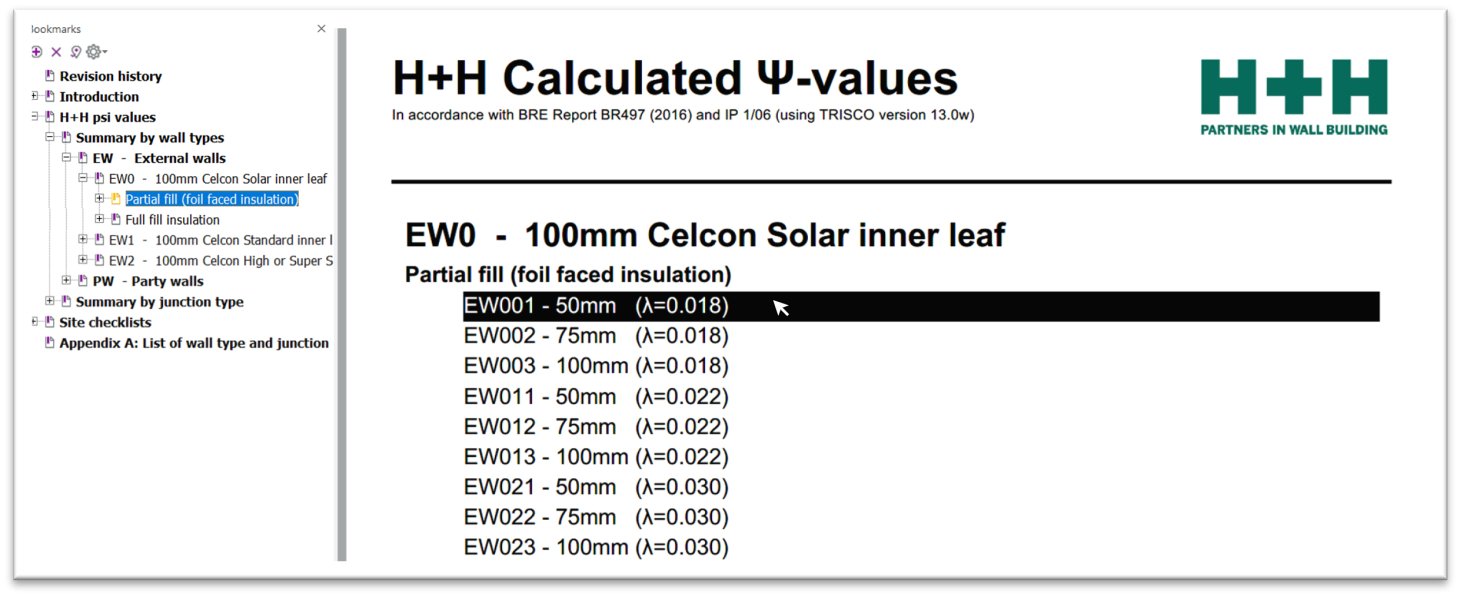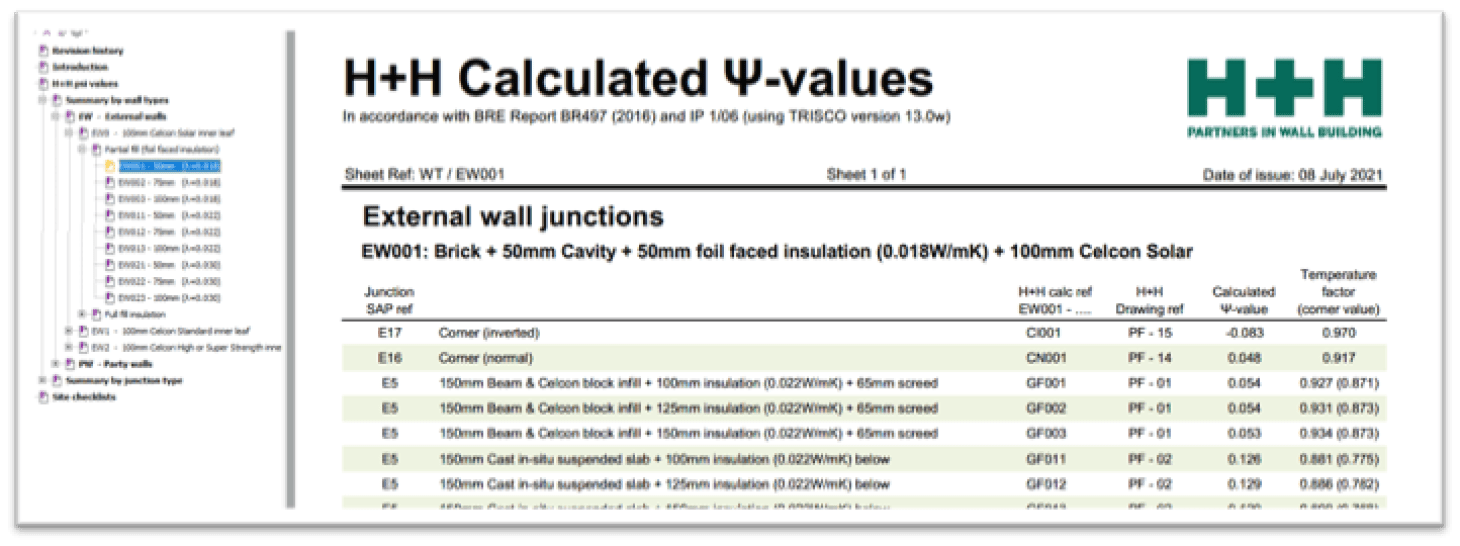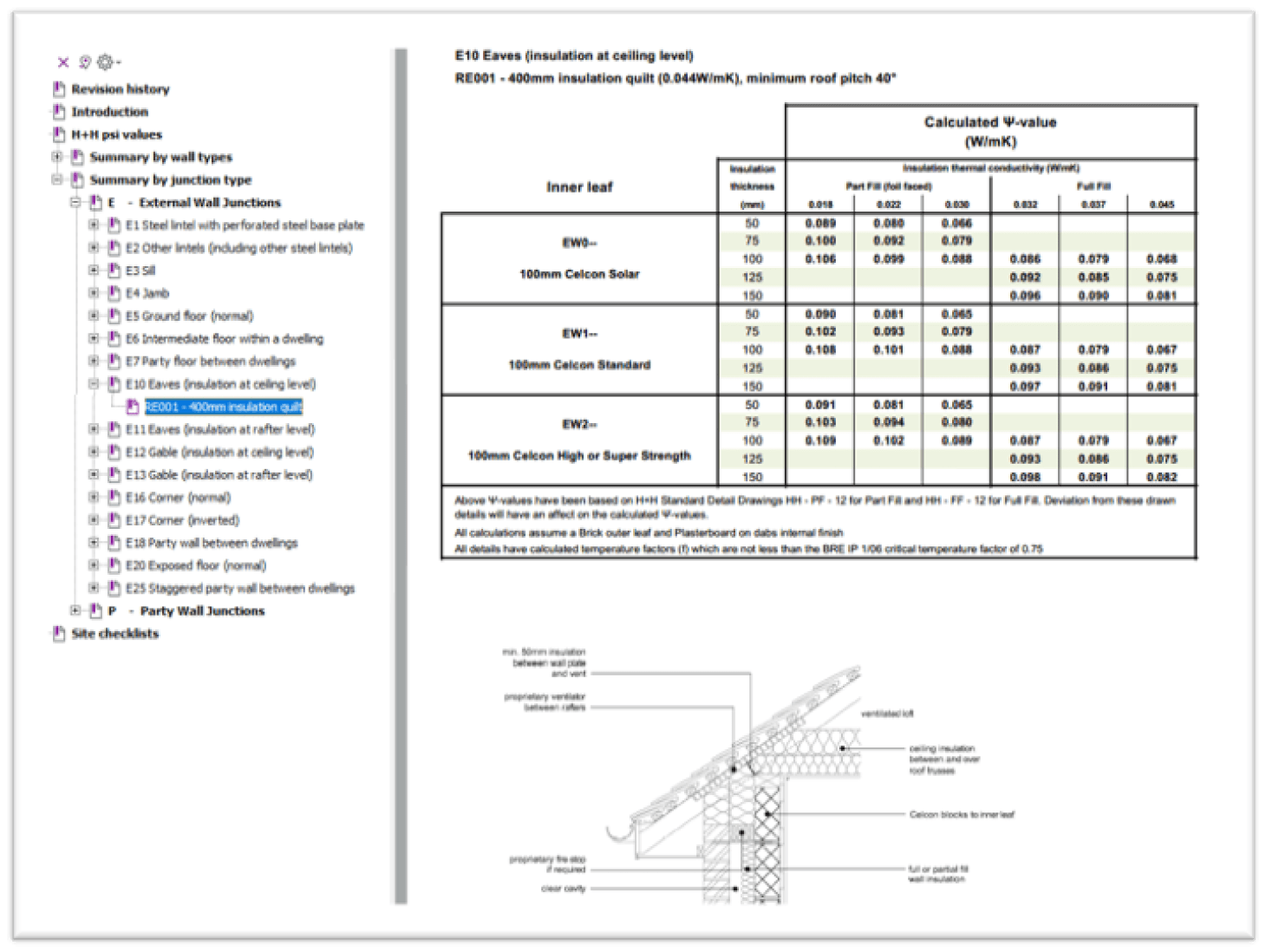Download H+H Calculated Ψ-Values
Please complete the form on the next page to download the latest version of the H+H Calculated Ψ-values pdf.
Introduction - Background
Heat losses through repeating thermal bridges, such as insulation bridged by cavity wall ties or stud framing, within a structure are accounted for by the calculation of the U-value of the plain element in question, however, thermal bridges (known as non–repeating or linear thermal bridges) also exist at junctions between elements or where the continuity of the external fabric insulation is interrupted (e.g. at junctions with external walls, floors and roof). With framing systems, the effect of the non-repeating thermal bridging can be quite significant due to the presence of additional structural elements in place of insulation at these locations. The relative effect of these non-repeating thermal bridges becomes more significant as U-values are driven down, to the extent that heat losses due to non-repeating thermal bridges can be up to 25-30% of the fabric only heat loss. Use of H+H aircrete can significantly reduce the thermal bridge effect at junctions, without having to resort to costly enhanced detailing at these locations, as it will have a far better thermal resistance than denser materials.
For Building Regulation purposes, additional heat losses associated with these thermal bridges are required to be accounted for in the SAP energy assessment calculations, (which in Appendix K gives a procedure based on a linear thermal transmittance value, Ψ (Greek letter Psi – pronounced "sigh"). The Ψ-value is a property of the thermal bridge junction and is the rate of heat flow per unit length of the thermal bridge.
Table K1 of SAP gives values of Ψ applicable to different types of junctions. These onerous values are known as Default values and are meant to be used where calculated or other Approved Details do not exist.
Regulations require that calculated values used have been calculated by a person with suitable expertise and experience following the guidance set out in BRE Report “BR497 Conventions for calculating linear thermal transmittance and temperature factors”. In addition, temperature factors should achieve a performance no worse than that set out in BRE Information Paper “IP 1/06 Assessing the effects of thermal bridging at junctions and around openings in the external elements of buildings”.
H+H UK Ltd have been actively involved in the development of generic aircrete Ψ-values for over 13 years with direct involvement in the production and development of the original APA Construction Details, BBA/RDL Constructive Details and the LABC Construction Details.
H+H Calculated Ψ-values
In order to provide the most up to date and accurate data where our blocks are being used, H+H UK Ltd have developed a comprehensive set of around 3,300 individual Ψ-values specifically covering our Solar (2.9N/mm²), Standard (3.6N/mm²), High Strength (7.3 N/mm²) and Super Strength (8.7N/mm²) blocks. Variations cover their use in partial or full fill in cavity walls, in beam and block floors, separating walls or as Foundation blocks below DPC.
The calculations conform to both BR497 (2016) and IP 1/06 and have been prepared in-house by our Technical team who have been involved with the previous projects mentioned above.
Evidence of competency and relevant training can be provided on request. Consequently, these calculated Ψ-values may be used by energy assessors in their SAP calculations to take full advantage of the inherent benefits of H+H aircrete blocks for all parts of the building fabric. They are specific to, and only valid for use with, the named H+H aircrete blocks and will be updated to reflect any changes to product specification as necessary. Consequently, they should not be used for other aircrete blocks of apparent similar specification. The Assessor should satisfy themselves that they are using the latest version of this document by reference to our website or our Technical Department via the contact details above, under TECHNICAL.
To provide maximum flexibility, whilst covering the most common forms of constructions, varying levels of insulation in the form of combinations of three different thicknesses and three different conductivities were considered. These represent typical wall U-values ranging from around 0.13 - 0.30W/m²K.
Approved Document L 2021 states that drawings should be provided for junctions. To allow proper coordination from initial Design, through SAP assessment to Site, all junctions considered here are consistent with, and referenced to, drawn H+H Construction Details which are available to download free of charge, in CAD or PDF format, from the downloads section of our website. When adopted at design stage, the designer can have confidence that the details used conform to best thermal practice. In addition, to aid the on-site audit requirement of the Approved Document, Site Checklists are provided for each wall type to enable feedback to the SAP assessor to help ensure that the final EPC reflects the as built conditions.
The comprehensive H+H Calculated Ψ-values document combines all relevant information in one place and has been designed to be easily navigated in the electronic PDF version using an extensive set of bookmarks or by clicking links within the individual pages.

For ease of reference, the Ψ-values are summarised by Wall Type, where external wall constructions are known, and by Junction Type for when comparisons between different wall types and levels of insulation are required. Ψ-values given for separating walls and floors are directly applicable to each dwelling without further division.
Summary by Wall Types

Split into 2 main External Walls and Party Walls sections, sub-sections cover block types, cavity width and insulation types where applicable. Each wall type is presented as table of Ψ-values covering 50 different junctions for external walls and 9 different junctions for party walls. In addition to the calculated Ψ-values for each Junction, also given are SAP Appendix K references (eg E17), with a brief description, individual H+H calculation reference numbers (eg EW001-CI001), applicable H+H Standard Detail Drawing references (eg HH-PF-15) and calculated temperature factors (although it should be noted that all are above the minimum critical temperature factor for dwellings recommended in IP 1/06).
References for each wall type and junction considered are listed in the Introduction of the document. (A sample page showing the References may be downloaded from the table below). Although the descriptions state Brick outer leaf, they are equally valid for any outer leaf as this part of the structure will not have a significant effect on the calculated values. For completeness, options for Dense Aggregate Concrete separating walls are given as we appreciate that they may be used in conjunction with our blocks being used in the inner leaves of the external walls. These have been based on generic Dense Aggregate Concrete blocks as a worse case but can also be used conservatively for lower density aggregate concrete blocks. (A sample of a "Summary by Wall Type" page may be downloaded from the table below).
Summary by Junction Types

As with the Wall Types section, Junction Types are also split into 2 main External Walls and Party Walls sections, with subsections corresponding to SAP Appendix K defined junctions. Each junction type is presented as table of Ψ-values covering all variations of relevant wall types and insulation thickness/conductivities where applicable. Also given are H+H Standard Detail Drawing references applicable to the junction together with an extracted drawing of the detail. (A sample of a "Summary by Junction Type" page may be downloaded from the table below).
Site Checklists
A complete set of Site Checklists are provided for each External Wall Type (Party Wall details are included so do not require a separate checklist). These have been developed for ease of use by Site in order to encourage their use and improve quality control procedures. Each form is dedicated to the variations applicable to the specific wall type and may be completed electronically or as hard copies and returned to the SAP assessor.The PDF format forms have been designed such that they can be filled in electronically by typing directly into the relevant boxes or selecting pre-determined options, either on a PC or a handheld smart device. If these are to be distributed electronically then it may be easier to download the individual Checklist from the table below for each applicable wall type rather than sending the complete document.The assessor has the option to fill in their own contact and site/project details before passing on to site, to further reduce the amount of information required from site and therefore encourage their completion. The rest of the form can be completed by selecting options and typing in details of the person filling in the form. Alternatively, if sending hard copies, then the relevant pages from the main document can be printed and forwarded on.
Solar
Grade Blocks
Standard
Grade Blocks
High Strength
Grade Blocks
Samples
Partial Fill
Full Fill
Partial Fill
Full Fill
Partial Fill
Full Fill
Download H+H Calculated Ψ-Values
Please complete the form on the next page to download the latest version of the H+H Calculated Ψ-values pdf.
